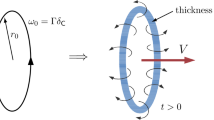Abstract
On the basis of representation of a turbulent fluid as an aggregation of independent turbulent particles (vortexes), we derive relations for the effective rate of chemical reactions and obtain a closed system of equations describing reactions with turbulent mixing of reactants. A variant of instantaneous reactions is considered that explains the proposed approach simply. In particular, the turbulent mixing events according to this approach are uniquely related to the acts of chemical interaction, which makes it possible to exclude from consideration the mixing of inert impurities–the most difficult point of the theory formulated using classical notions. The obtained system of equations is closed without introducing arbitrarily adopted correlations, by naturally introducing the concept of effective reaction and writing the equations of conservation for both the concentrations of reactants and their volumes.
Similar content being viewed by others
References
R. I. Kuznetsov and S. A. Sabel’nikov, Turbulence and Combustion (Nauka, Moscow, 1983) [in Russian].
Prediction Methods for Turbulent Flows, Ed. by W. Kollmann (Hemisphere, Washington D.C., 1980; Mir, Moscow, 1984).
R. W. Bilger, in Turbulent Reacting Flows, Ed. by P. A. Libby and F. A. Williams, (Springer-Verlag, Berlin, 1994).
Turbulent Reacting Flows, Ed. by P. A. Libby and F. A. Williams (Academic, New York, 1994).
S. B. Pope, in Advances in Turbulence: X, Ed. by H. I. Andersson and P.-A. Krogstad (International Center for Numerical Methods in Engineering (CIMNE), Barcelona, Spain, 2004), p. 529.
R. W. Bilger, S. B. Pope, K. N. C. Bray, and J. F. Driscoll, Proc. Combust. Inst. 30, 21 (2005).
J. Warnatz, U. Maas, and R. W. Dibble, Combustion: Physical and Chemical Fundamentals, Modeling and Simulation, Experiments, Pollutant Formation (SpringerVerlag, Berlin, 2001; Fizmatlit, Moscow, 2006).
S. P. Burke and T. E. W. Schumann, Ind. Eng. Chem. 20, 998 (1928).
W. R. Hawthorne, D. S. Weddell, and H. C. Hottel, Third Symposium on Combustion and Flame and Explosion Phenomena, Madison, Wisconsin, September 7–11, 1948, Ed. by B. Lewis (Williams and Wilkins, Baltimore, Maryland, United States, 1949), p. 266.
H. L. Toor, Am. Inst. Chem. Eng. J. 8 (1), 70 (1962).
P. V. Danckwerts, Gas–Liquid Reactions (McGrawHill, New York, 1970; Khimiya, Moscow, 1973).
Author information
Authors and Affiliations
Corresponding author
Additional information
Original Russian Text © V.P. Vorotilin, Yu.G. Yanovskii, 2015, published in Zhurnal Eksperimental’noi i Teoreticheskoi Fiziki, 2015, Vol. 148, No. 1, pp. 166–177.
Rights and permissions
About this article
Cite this article
Vorotilin, V.P., Yanovskii, Y.G. Estimating the effective rate of fast chemical reactions with turbulent mixing of reactants. J. Exp. Theor. Phys. 121, 145–154 (2015). https://doi.org/10.1134/S1063776115060163
Received:
Published:
Issue Date:
DOI: https://doi.org/10.1134/S1063776115060163




